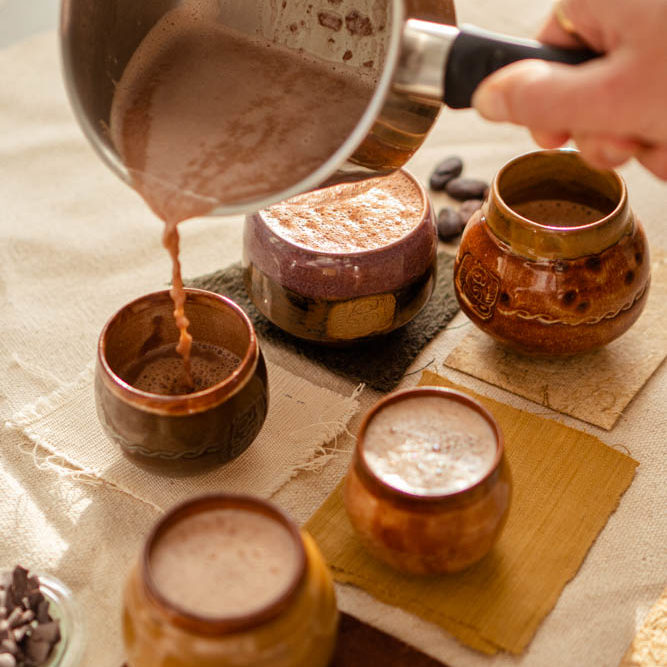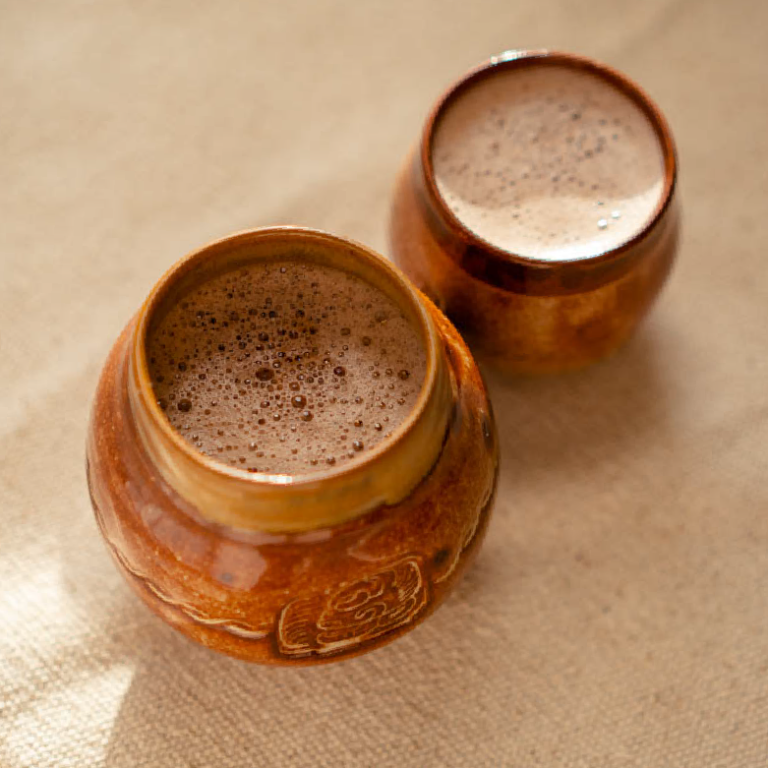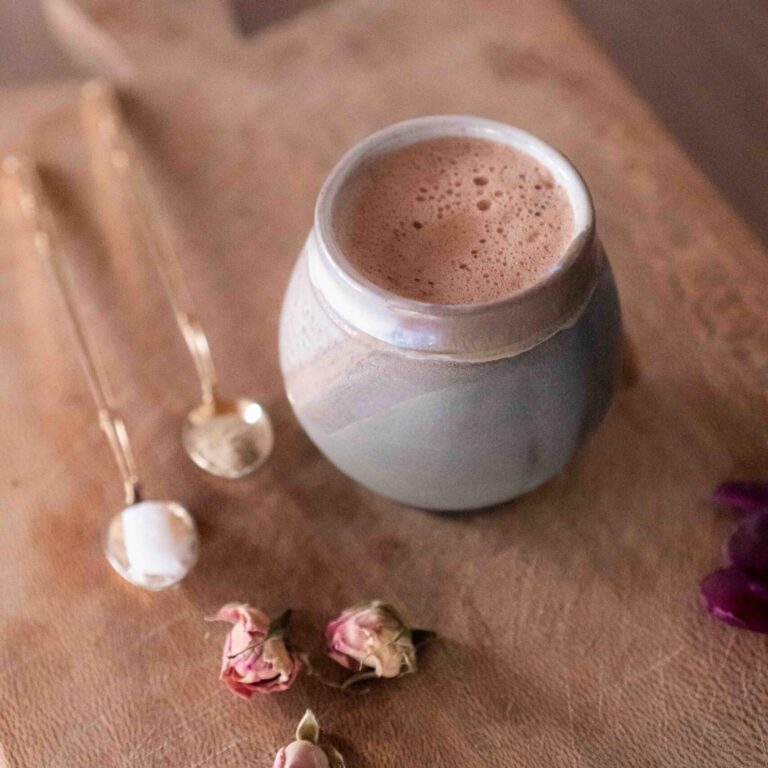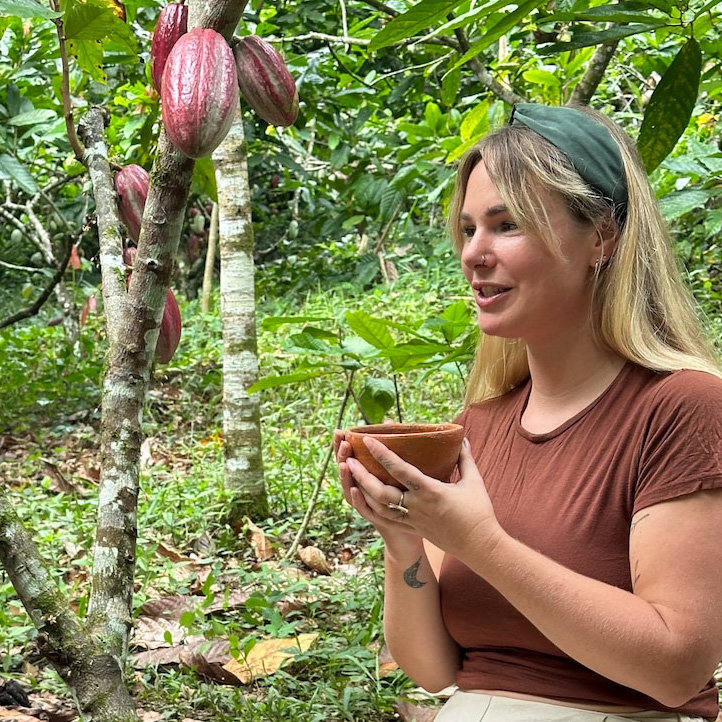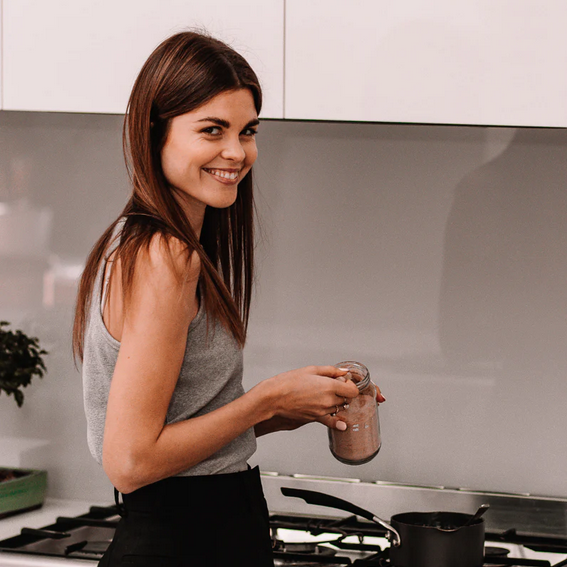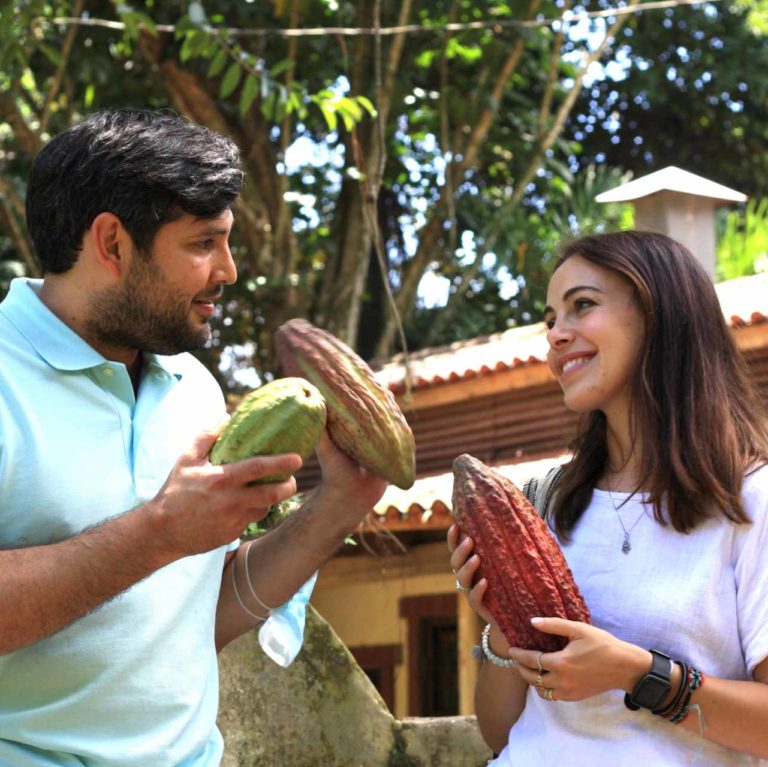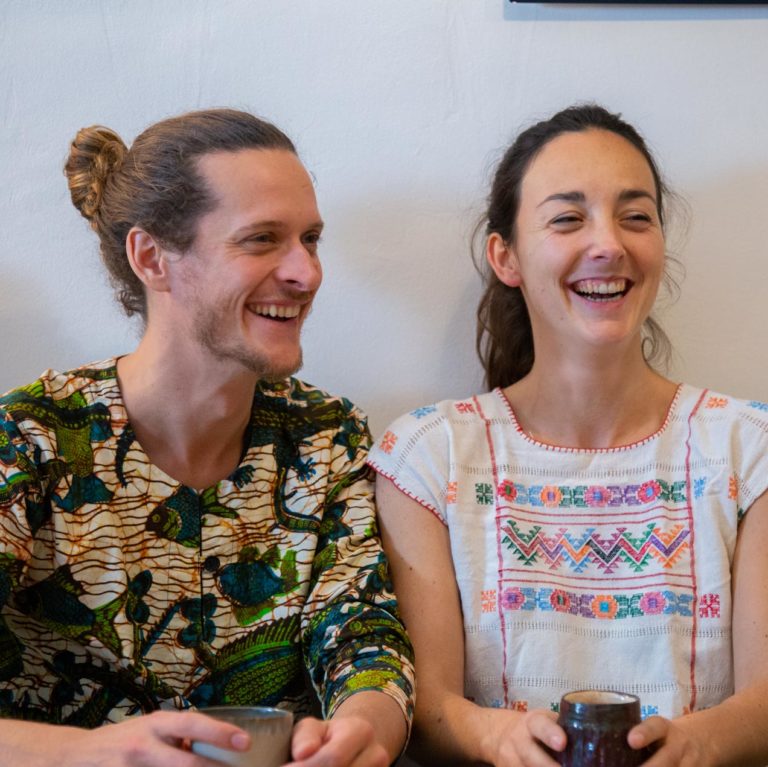The making of Bean-to-bar chocolate
— A dive into the craft of Mathieu Robin who embarks us on his chocolate making journey.
CONTEXT
◇ What did the remaining 2-5% decide to do?
Simply the same thing as a winemaker who cares about the varieties grown and terroir on which they grow. Who has know-how in the transformation, who respects the soil as well as the other human beings involved in the process.
Their chocolate is made straight from the cacao beans. A decision that appears simple but is in no way trivial. This requires, among other things, meticulous work, unfailing patience, and a sincere let go since, just like great wines, its aromas never unveils in quite the same way.

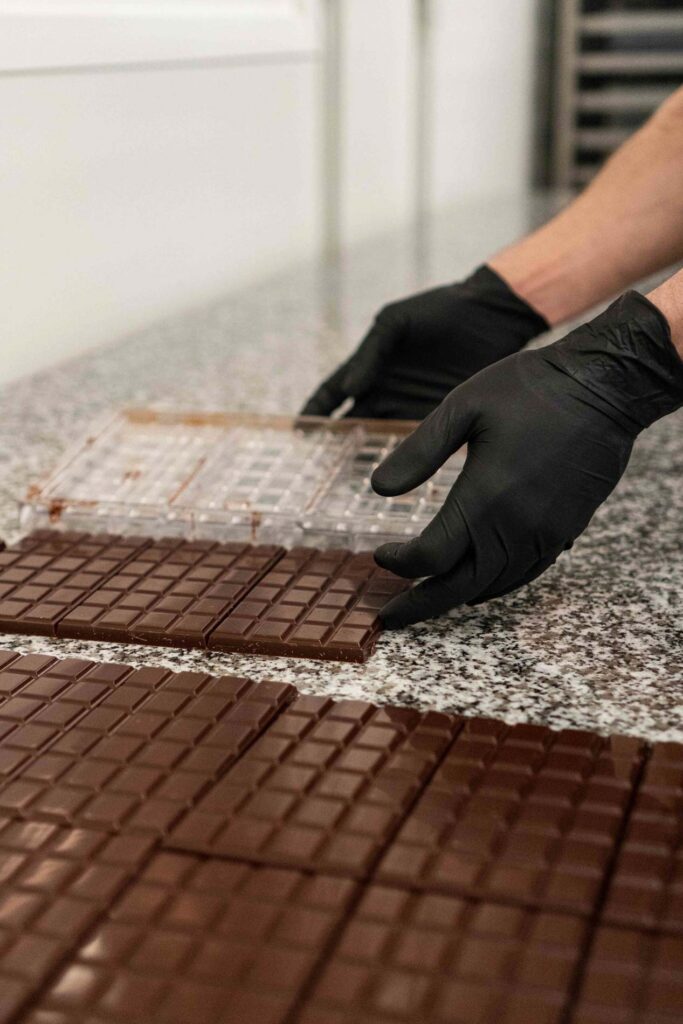
The photos that follow reveal the work of Mathieu Robin, in charge of transforming cacao beans into bars for the eponymous house created by his father Hervé in 2013, in Périgueux, France.
A chronological sequence of the production stages, which allows two things:
- An explanation of the bean-to-bar method and philosophy,
- An understanding of the maker’s role; more precisely, how the way he appropriates the method impacts the end product.
More than a photographic report, this article is designed as a proper dive into the world of Mathieu and cacao.
I want to thank him for sharing his passion for the essence of chocolate with me.
I also want to thank all the members of Hervé Robin’s lab for their warm welcome and vibrant taste for sharing.
I. SOURCING
The first step of this process begins well ahead of actual production in the workshop. Also, it immediately sets the craft chocolate maker apart from its conventional counterparts. This step is called sourcing.
It consists of finding fine (also called specialty) cacao beans from farms, plantations, or cooperatives that have grown the cacao trees, harvested the pods, as well as perfomed a few “post-harvest” processes (i.e. fermentation and drying of beans). The latter are crucial for beans’ conservation and ultimately for chocolate’s quality.
Sourcing can be done in person, or via specialized intermediaries.
In the first case, the maker travels to cacao-producing countries and meets farmers and cooperative managers, in order to become familiar with the varieties and cultivation practices.
In the second case, this work is delegated to focus solely on sampling.
Mathieu chose the second option and works hand in hand with various sourcers responsible for providing him with batches of beans matching his aspirations. Looking for a particular aromatic profile, a specific variety, a selected terroir… Many criteria make up the diversity of cacao and chocolate.
He uses these to carry out «test batches», a limited quantity of chocolate bars in order to get a precise idea of a cacao’s potential.
When a batch is validated, an order is placed with the sourcer who’s generally responsible for importing the beans from the producing country to the chocolate maker’s workshop.
II. HAND SORTING BEANS
Cacao’s finesse as well as some confidence placed in the producers are necessary but are not sufficient for the creation of exceptional chocolate. The bean-to-bar method involves respecting a precise protocol if we wish to achieve a satisfactory result. Flexibility is possible in the form, rigor is necessary in the execution.
A rigorous method in essence but Mathieu isn’t satisfied with it alone.
Devoted to his creations, he moves the cursor from rigor to exigency and reveals to me his infinite quest for perfection. Not without recalling ikigai and the philosophy linked to Japanese craftsmanship, he tells me how the careful execution of each gesture renews a virtuous cycle for him every day. The deepening of mastery, the appreciation of the result, a sort of pace creating a calming balance between control and detachment.
A high level of exigency is therefore the basis of this balance. It serves the achievement of each stage of transformation in order to allow the purest expression of a bean’s potential.
Thus begins the meticulous work of the craftsman.
Once removed from the bags, Mathieu sorts beans by hand in order to extract any unwanted inputs (unripe or overly fermented beans, debris, etc.)
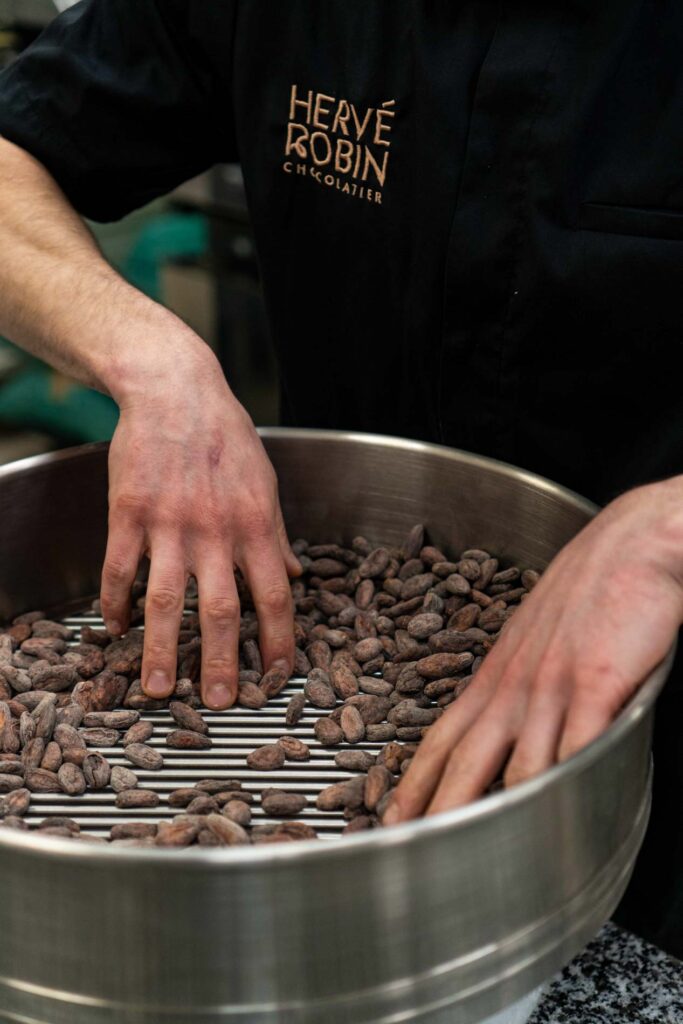
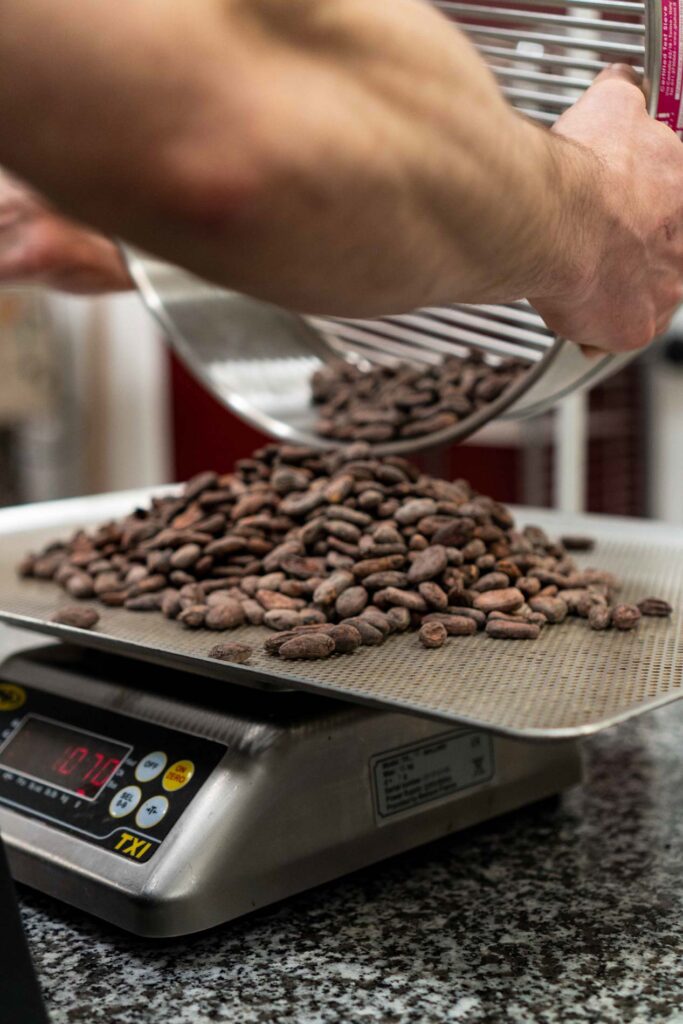
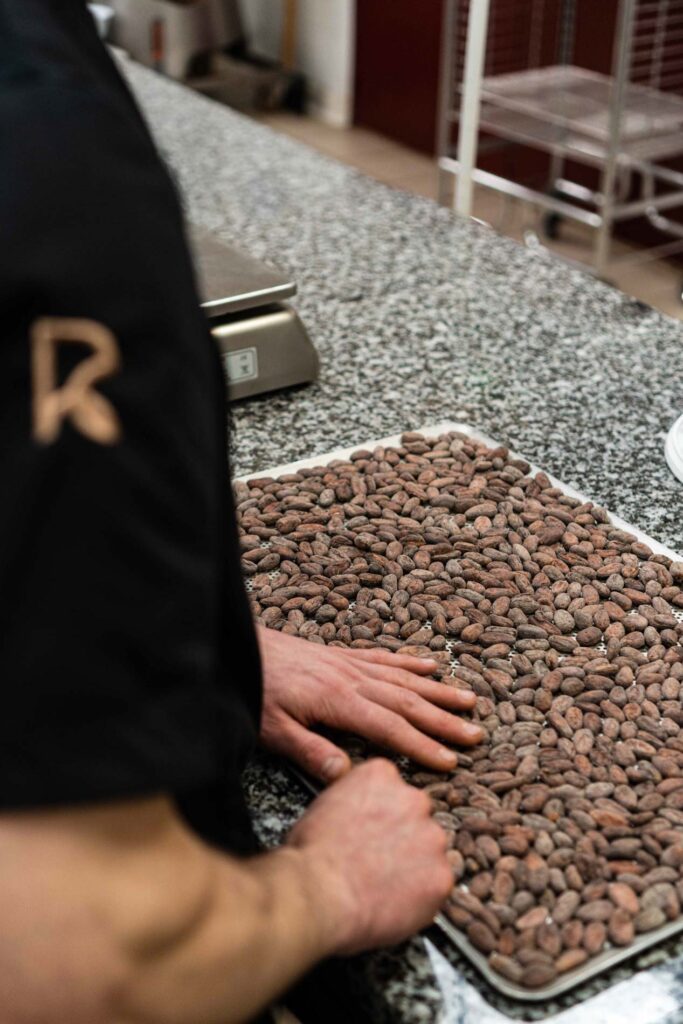
III. ROASTING
Once sorted, beans are roasted, meaning they’re slowly heated, dried without being burned, in order to develop aromas and reveal flavors. To do this, Mathieu uses an oven and perforated plates. Cacao beans are arranged to allow for an even heat circulation and uniform roasting without having to turn them.
Depending on the desired aromatic profile, each bean-to-bar maker defines its own roasting parameters (durations & temperatures), which differ for each batch of beans, even if they come from the same plantation.
Indeed, fluctuations in growing conditions (rainfall, sunshine, etc.) and post-harvest processing impact the beans’ quality. Adaptation is therefore essential.
The whole is called a “roasting profile”: several heating stages are carried out, each in a specific amount of time.
Again, exigency here is key for Mathieu. Rather than relying on common versatile profiles that have nothing left to prove, he carries out numerous tests ahead of production in order to achieve a result that honors the specificities of the actual bean.
Those are precious data, proper manufacturing secrets since they make the craft chocolate maker’s “touch” and are sometimes enough, for the most seasoned pallets, to recognize the author of a bar.

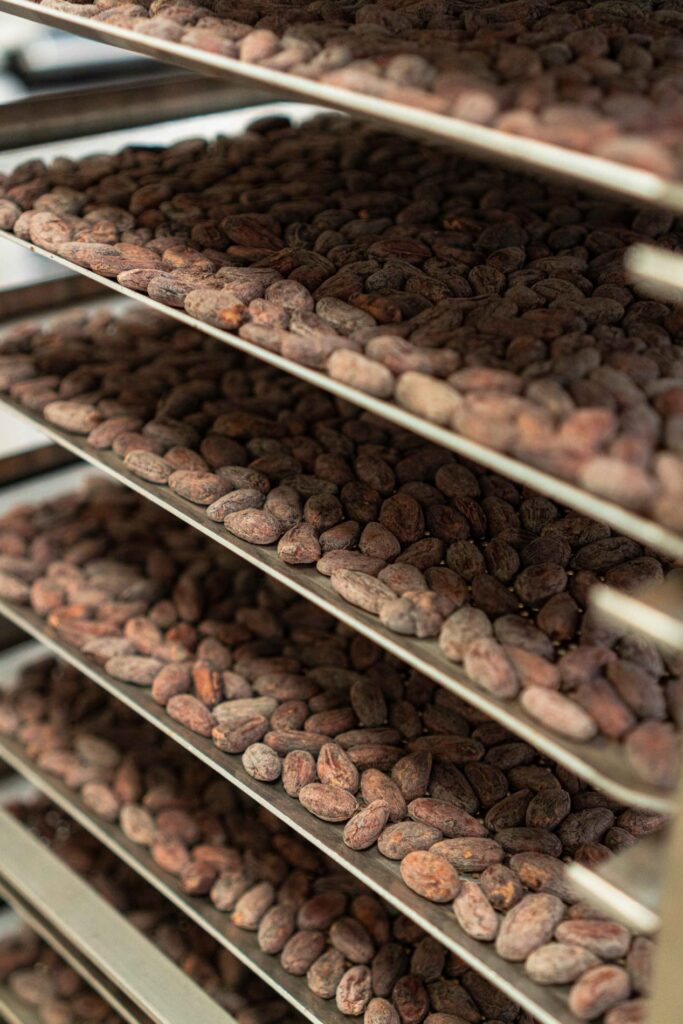
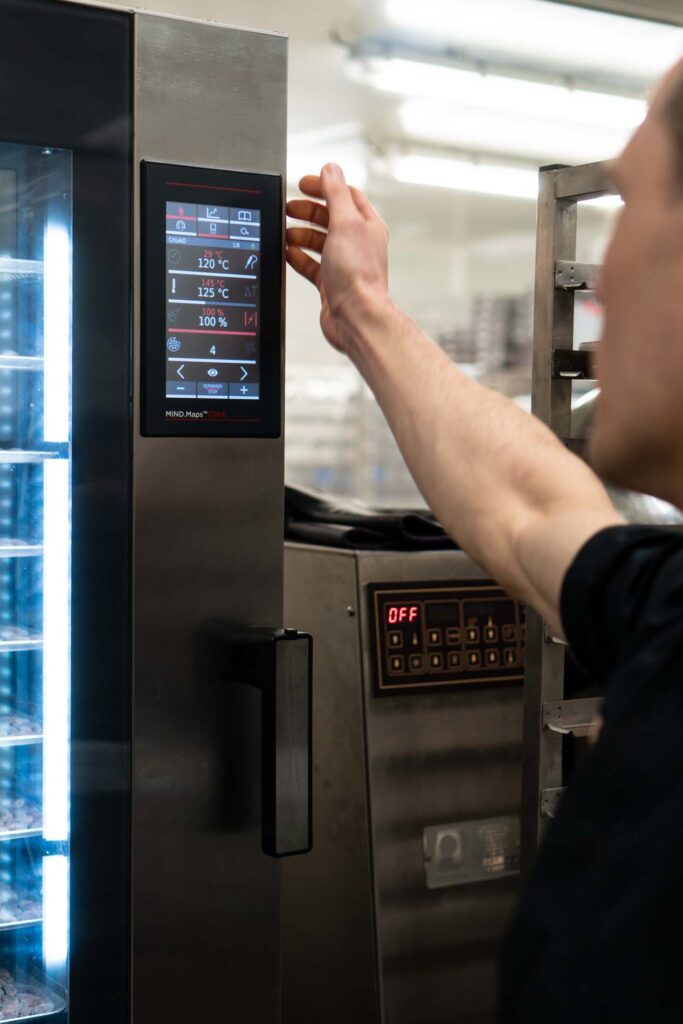
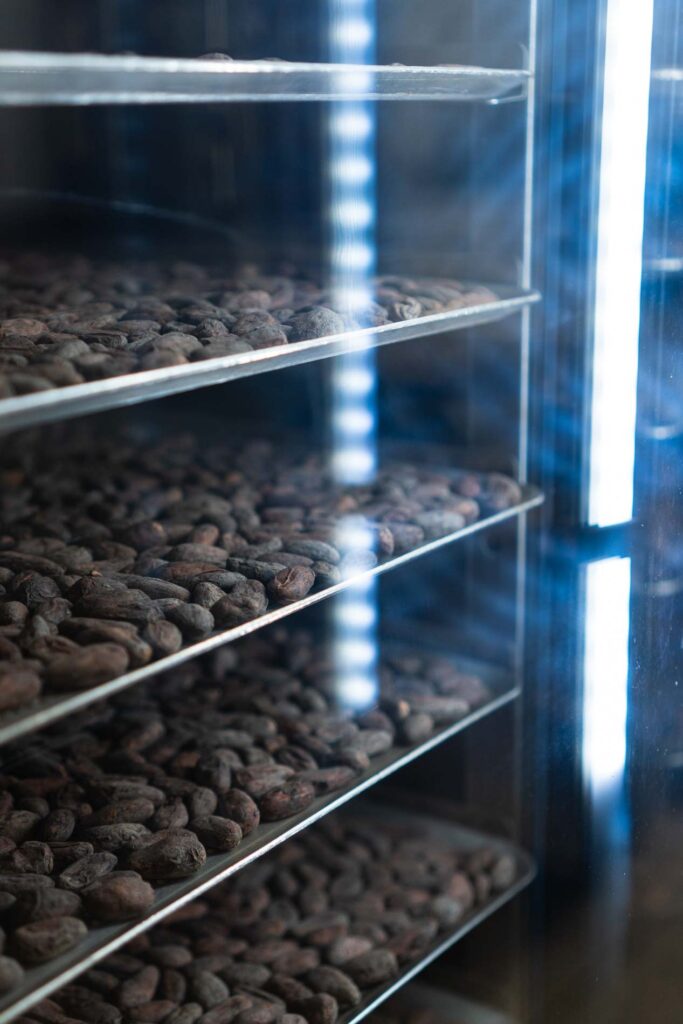

In addition to revealing its aromas, roasting cacao improves the bean’s assimilability by our body and therefore optimizes its nutritional qualities. It also eliminates residual bacteria from fermentation and drying, and facilitates the next stage of winnowing.
The bean-to-bar philosophy advocates gentle and slow roasting of the bean, thus preserving its properties and nutrients.
Nothing like the dominant industrial practices which simply consist of a high and quick roasting, ending up burning the beans. A shortcut facilitating their transformation since it avoids the sorting stage and standardizes their taste, which is then smoothed out with a lot of sugar, cacao butter and synthetic vanilla aroma.
Have you ever found dark chocolate “too bitter”? Blame it on the roasting, it’s the good taste of burnt.
IV. CRUSHING & WINNOWING
Once roasting is complete, the beans are cooled down before being crushed and winnowed.
Winnowing consists of separating beans from their shell, the husk.
Crushing reduces the beans to pieces in order to facilitate their grinding. We then obtain cacao nibs.
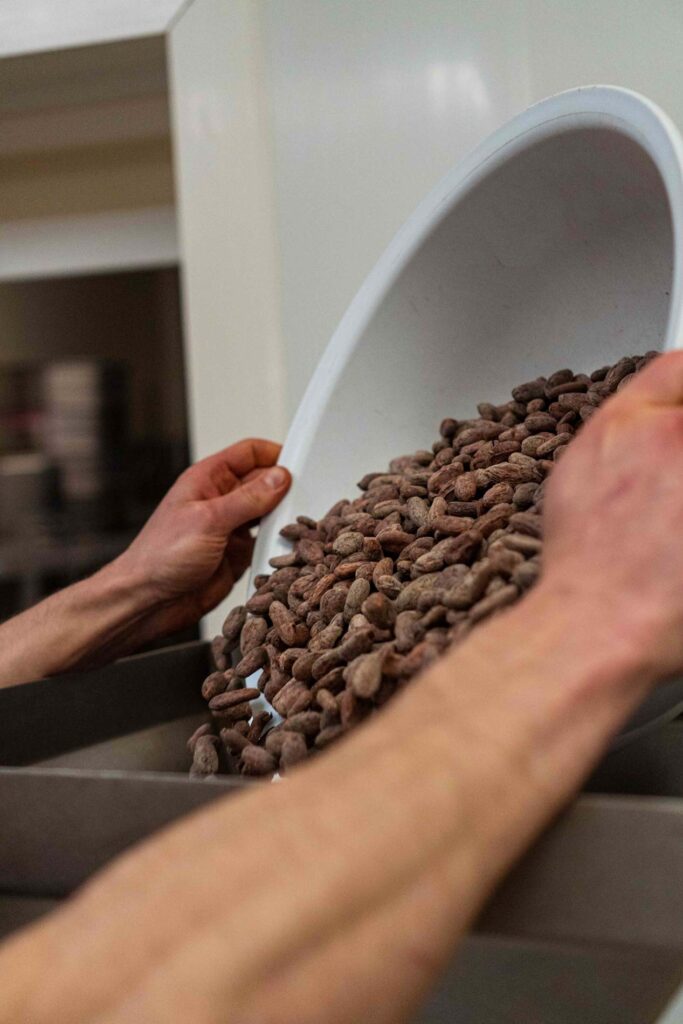
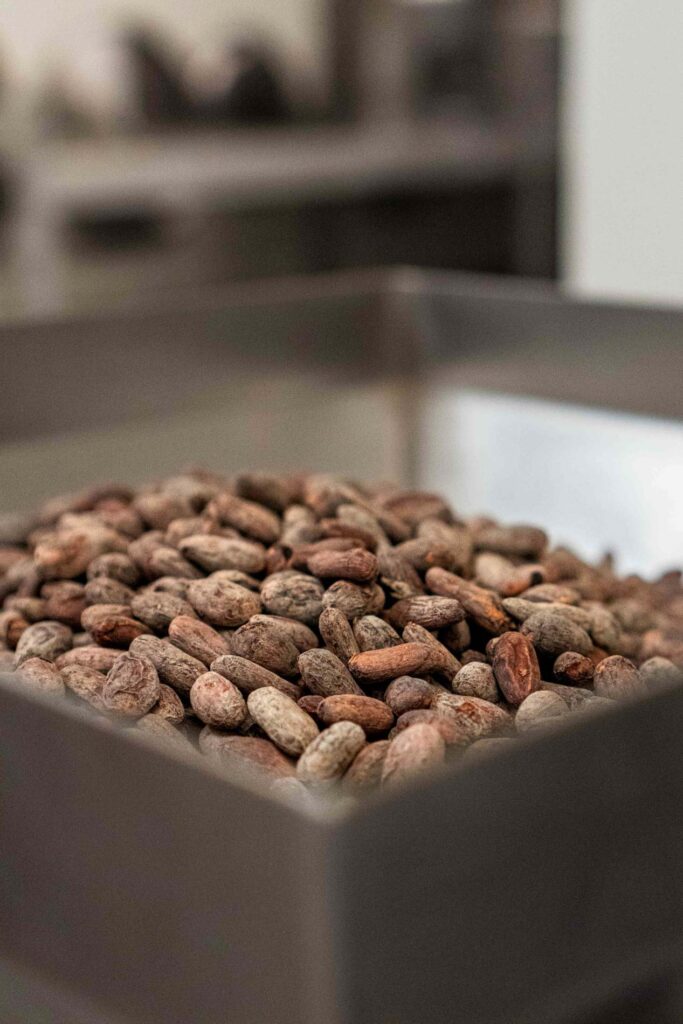

A 2-in-1 step: beans pass through a winnower which crushes them and separates husks from the nibs with a blast of air.
Mathieu carries out three passes of the winnower for each batch in order to obtain greater fineness of the nib and to reduce the presence of husks in it.
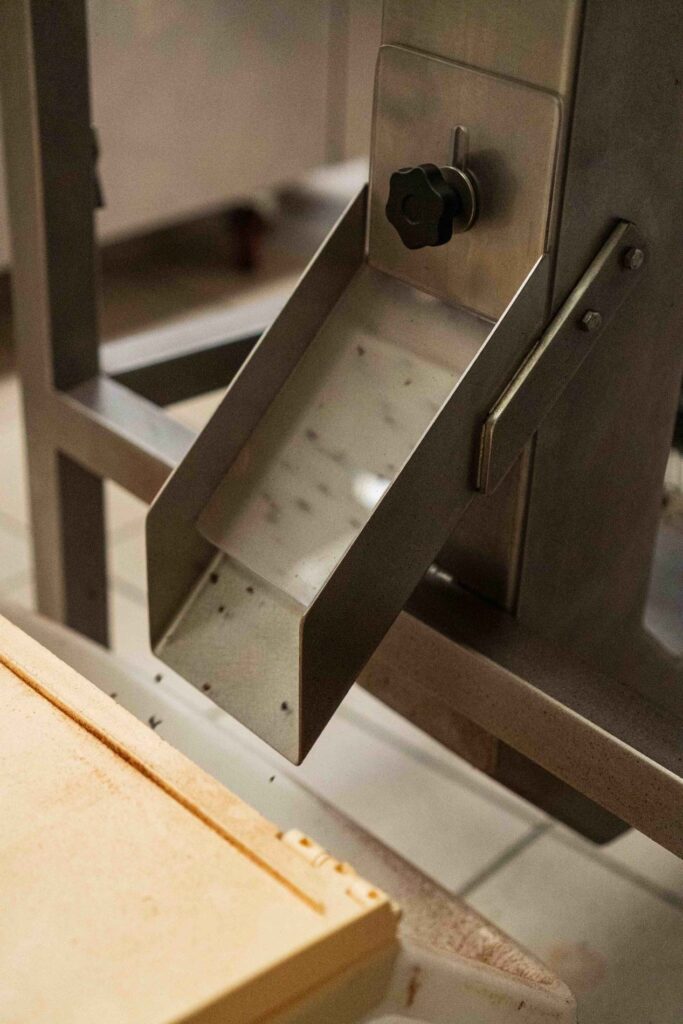
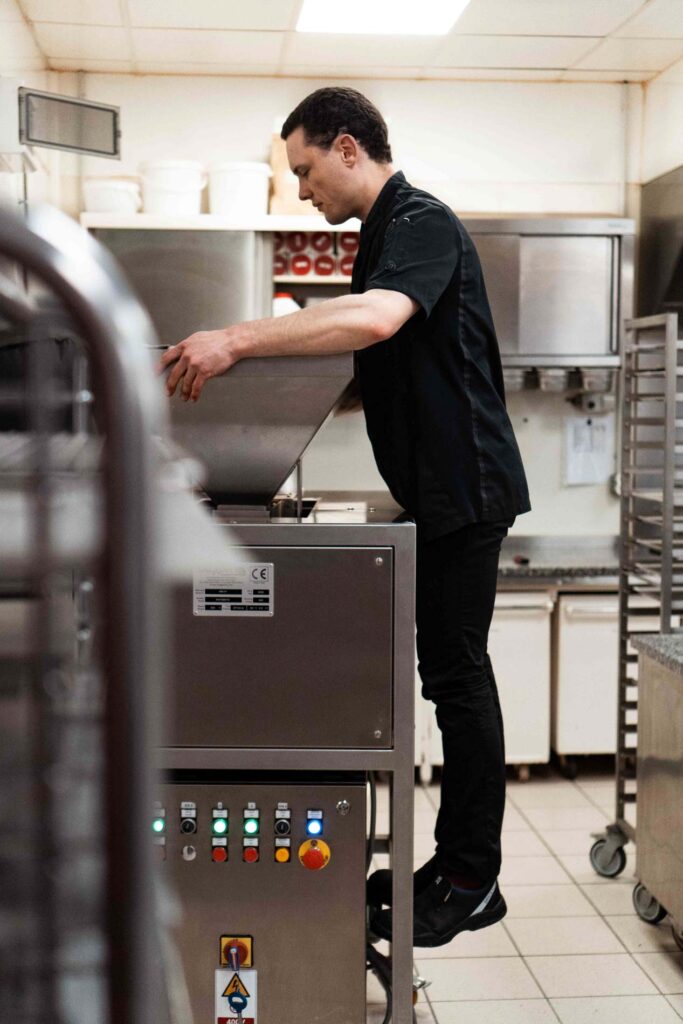
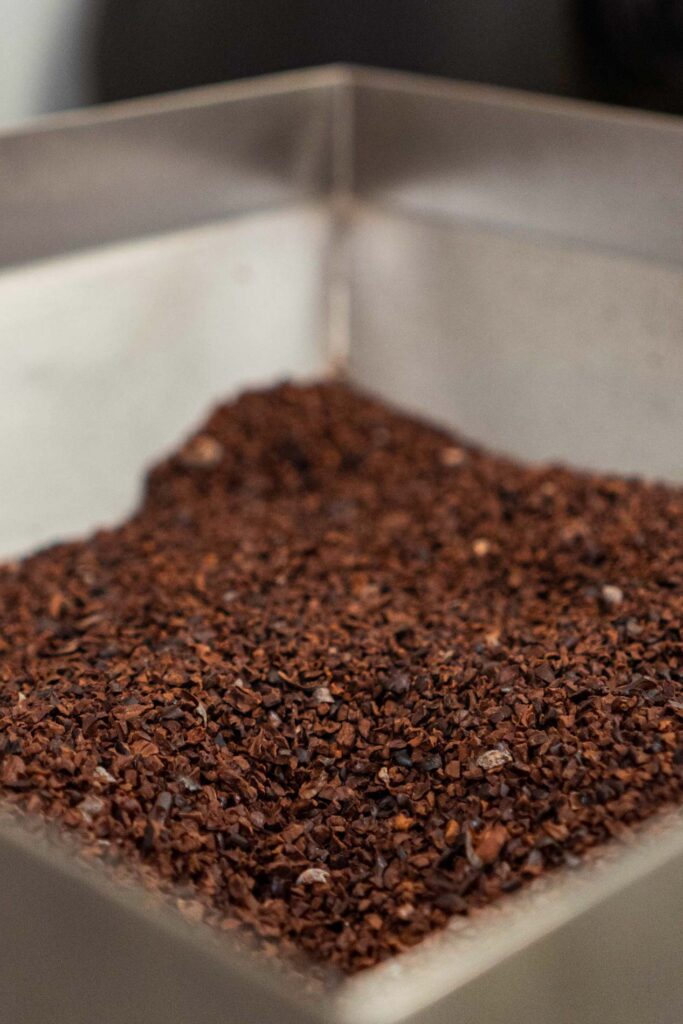
V. SORTING NIBS
Before being ground in the mill, nibs are sorted. The last remaining husk residues are removed by hand in order to reduce the presence of fibers to the strict minimum, otherwise altering the texture and taste of chocolate.
A meticulous and time-consuming operation which alone testifies to the devotion of the craftsman. The time spent by Mathieu carrying out this sorting is on average equivalent to the time necessary to carry out all the other accumulated steps. An extraordinary investment of energy for a result that seems trivial to the untrained eye, but which is clearly felt in the purity of the end product.
A new expression of the Périgord’s chocolatier’s level of demand. In the details lies the difference between excellence and exception.



VI. LOADING THE MILL
The fateful stage during which the cacao becomes chocolate.
Nibs are crushed and reduced to a paste; Mathieu uses a stone grinder for this purpose.
An informed choice since it is a hybrid between artisanal and semi-industrial practice: it allows the process of a significant cacao quantity, while limiting the transformation’s intensity.
In addition, it also plays the role of a conch, a machine present in most chocolate factories. Its role is to stir the paste for 24 to 72 hours, mainly to homogenize the texture while eliminating certain undesirable aromatic compounds.
The fat contained in the beans (on average 50% of their constitution), commonly called cacao butter, is released under the pressure and friction exerted by the wheels.
Loading is done gradually, adding nibs kilogram by kilogram in order to ease the mill’s motion.


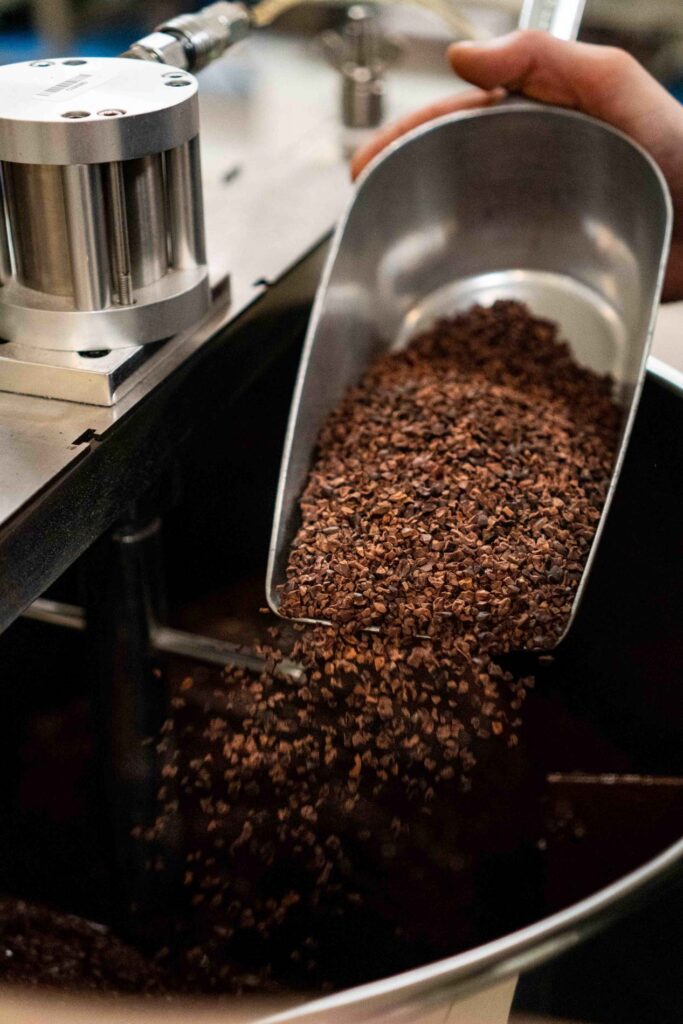
A couple of hours are enough for the mill to transform this rough mass into a viscous paste, indicating to Mathieu that it’s time to add the second and final ingredient of his recipe: sugar.
This is one of the key principles of the bean-to-bar method: less is more.
Two-ingredient chocolate first appeared in the late 2000s in the U.S. Since then, craft chocolate maker’s list of ingredients started to shrink. The addition of flavorings, lecithin or cocoa powder is prohibited.
Some bean-to-bar chocolatiers retain the addition of cacao butter in their recipe. Mathieu rather use what the beans have to offer and adapt his process accordingly. The mill’s mixing time therefore varies depending on the batch, which allows him to achieve the desired homogeneity.
This step is often synonymous with demarcation in the bean-to-bar world since it enables the search for a signature texture, silky, rough, or somewhere in between. Mathieu has chosen his side, that of finesse.

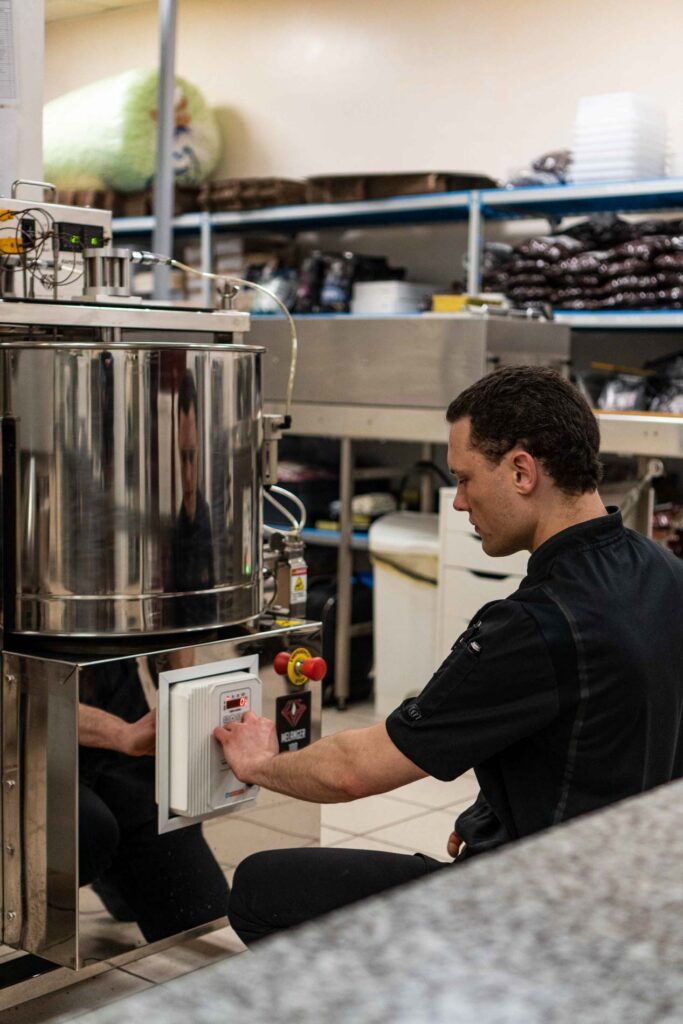

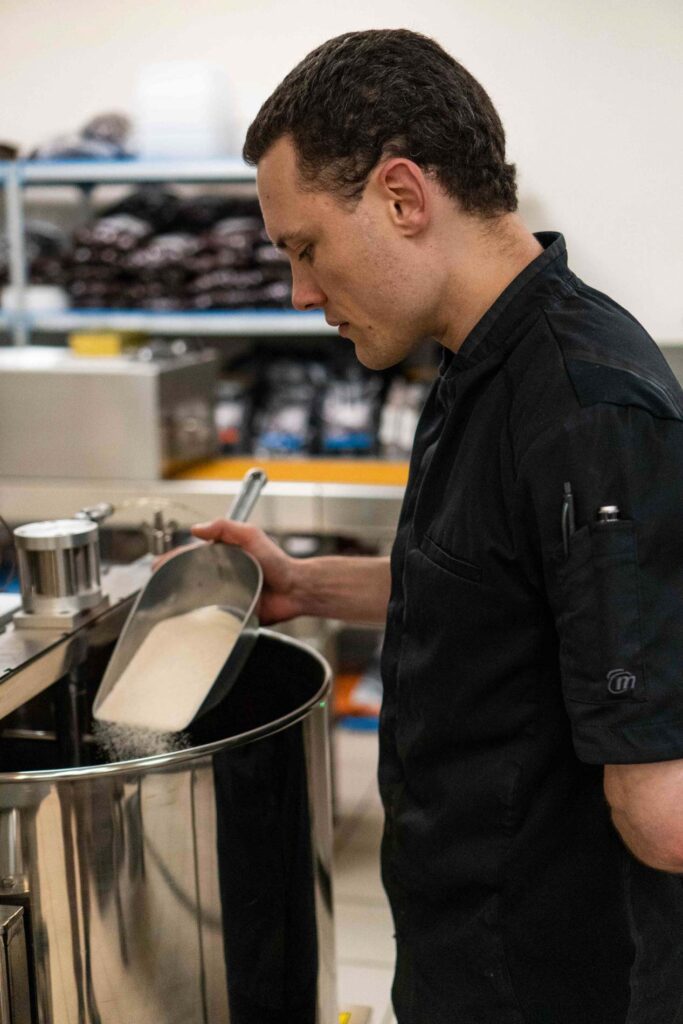
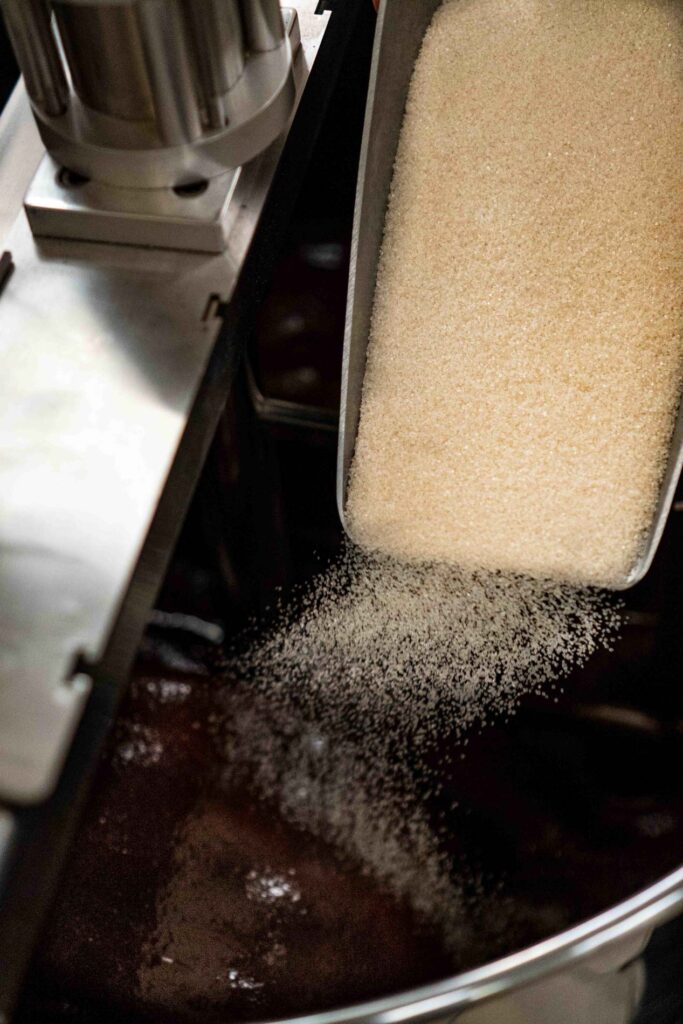
VII. UNLOADING THE MILL
After 72 hours of operation, sugar and cacao coexist homogeneously and the chocolate’s aromatic profile displays complex flavors and subtle notes.
A grindometer test is performed to analyze the particle size of the paste.
The goal set by Mathieu: a reduction of particles to a diameter of 15 microns, synonymous with a perfect texture.
The test is conclusive, it is time to unload.
Final precautions before the brown gold flows, preheating the strainer (serving as a last filter) and the container in order to avoid thermal shock and premature crystallization of the cacao butter.



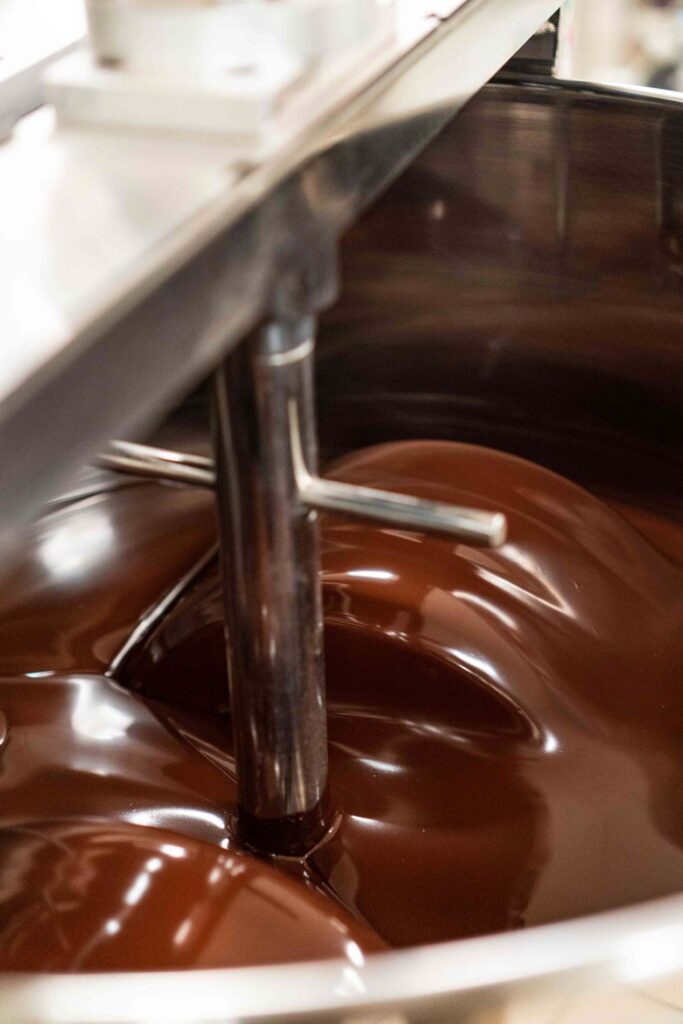
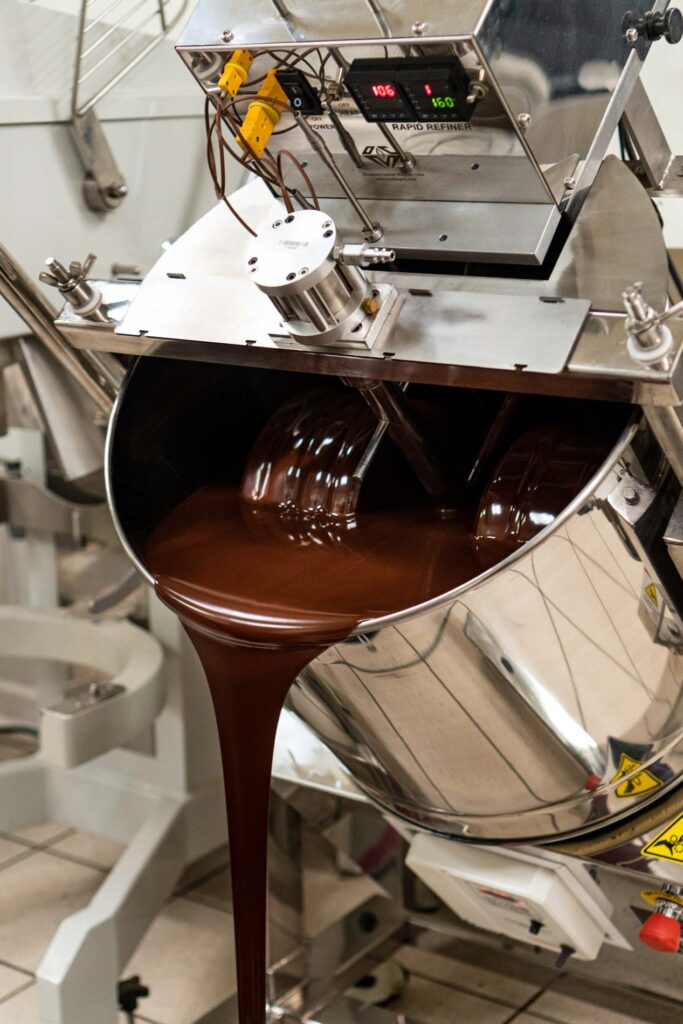

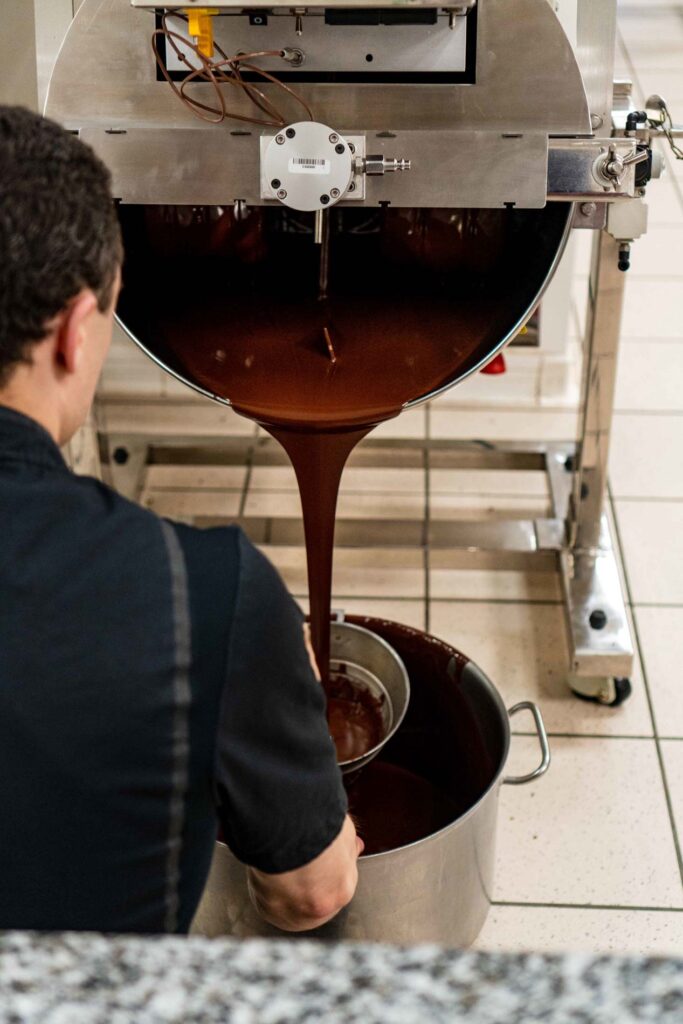

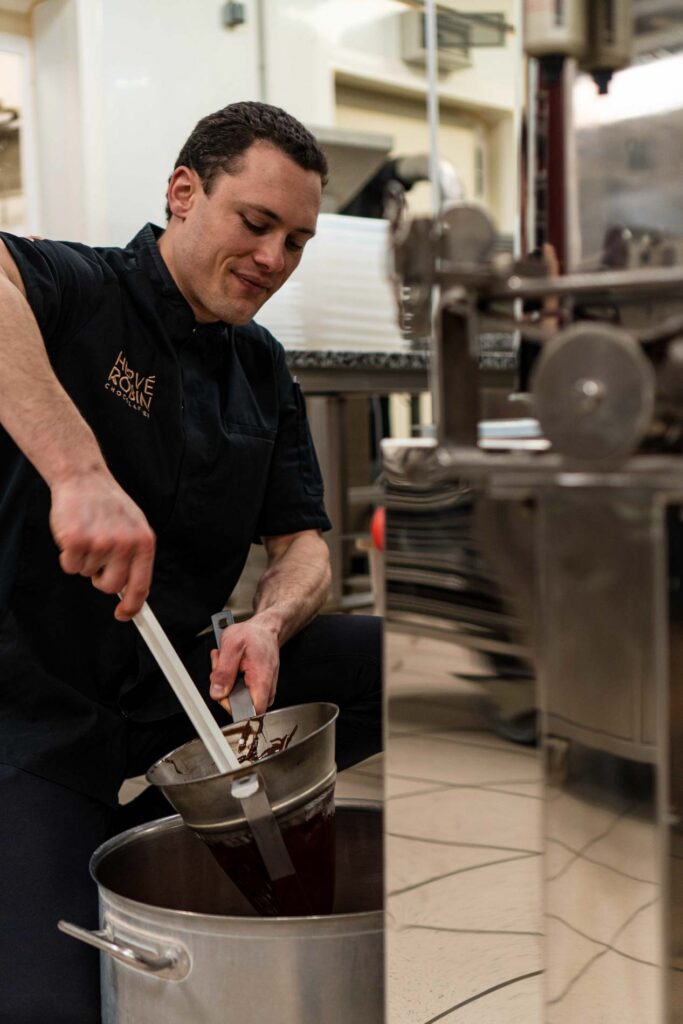
From this moment on, the chocolate will no longer undergo any processing. However, it has not yet completed its transformation process. Packaged in 3kg plates, it is stored for several months and begins a maturation process.
The chocolate will “work”, its aromas will evolve, sometimes going so far as to deceive the artisan in his projections at the time of its release for molding.
This is where the magic of chocolate is in full swing: despite the extreme finesse with which cacao is processed, it is up to the bean to have the last word on the flavors it will reveal.
A lesson in humility that Mathieu welcomes with open arms at each execution. He shares with me the pleasure he sometimes feels in being surprised, rediscovering the profiles of certain cacaos, refining his understanding of his decisions’ impact. Working with cacao beans is an endless learning experience for him.
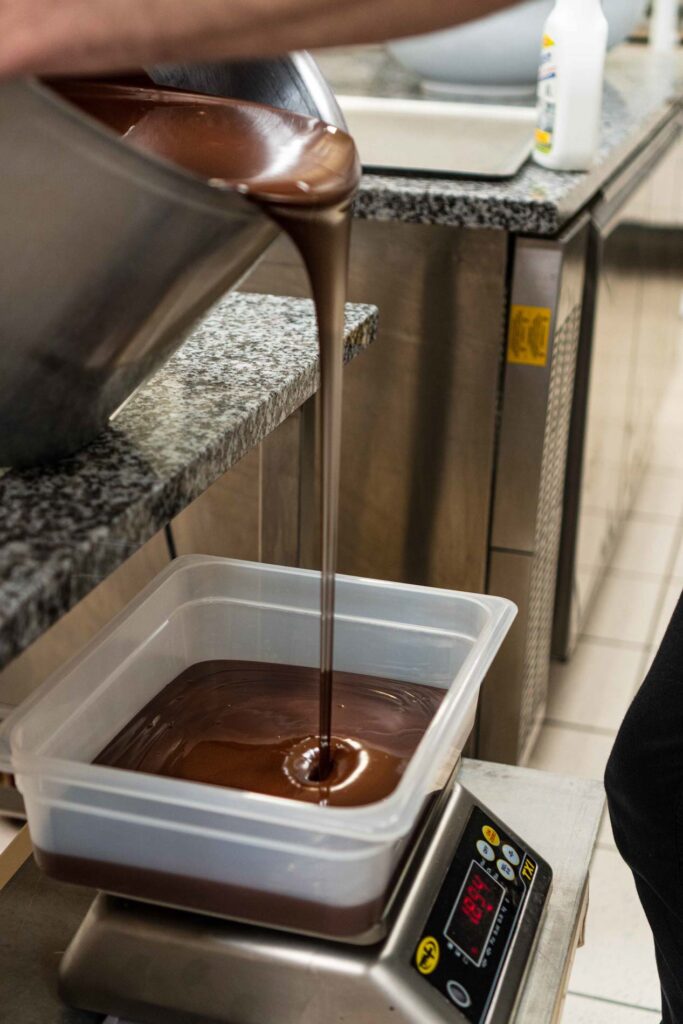
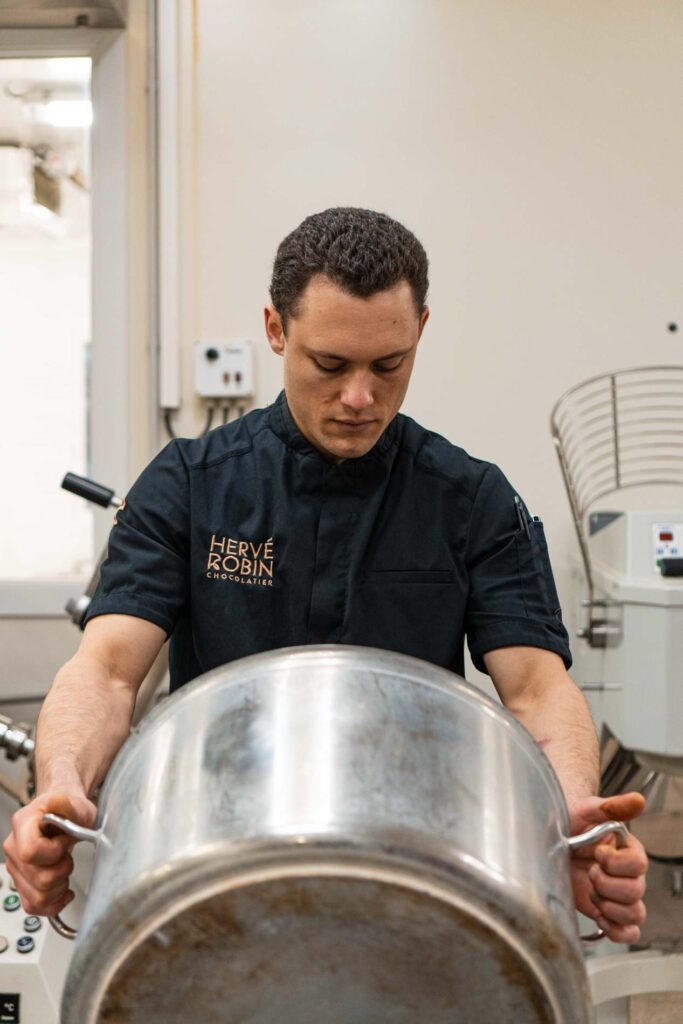
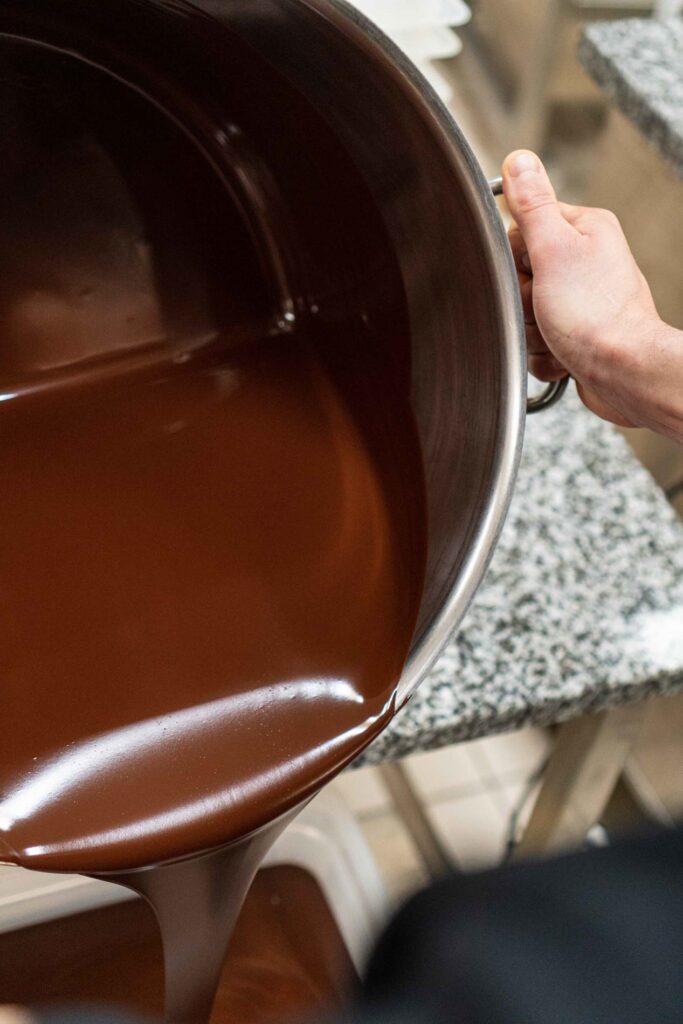
The cacao processed here on the pictures is a Chuao, a well known designation amongst fine chocolate enthusiasts. It comes from an eponymous plantation located in Venezuela. More than a variety, this name designates what would be an equivalent of a cépage, since it takes into account genetic and geographical characteristics.
Once again like wine, the qualities of a cacao are evolving and determined harvest after harvest, taking into account a large number of factors. A country of origin, or a variety does not provide enough information to judge the quality of a chocolate, just as a “vin de France” or a Chardonnay indicates nothing about the quality of a wine.
Cultivation practices, climate, orientation of a plot, altitude, rainfall… Dozens of uncontrollable parameters subtly modify the flavors of each harvest. A renewed challenge for the craft chocolate maker, and a unique taste experience, specific to each bar, for those who have the chance to taste it.
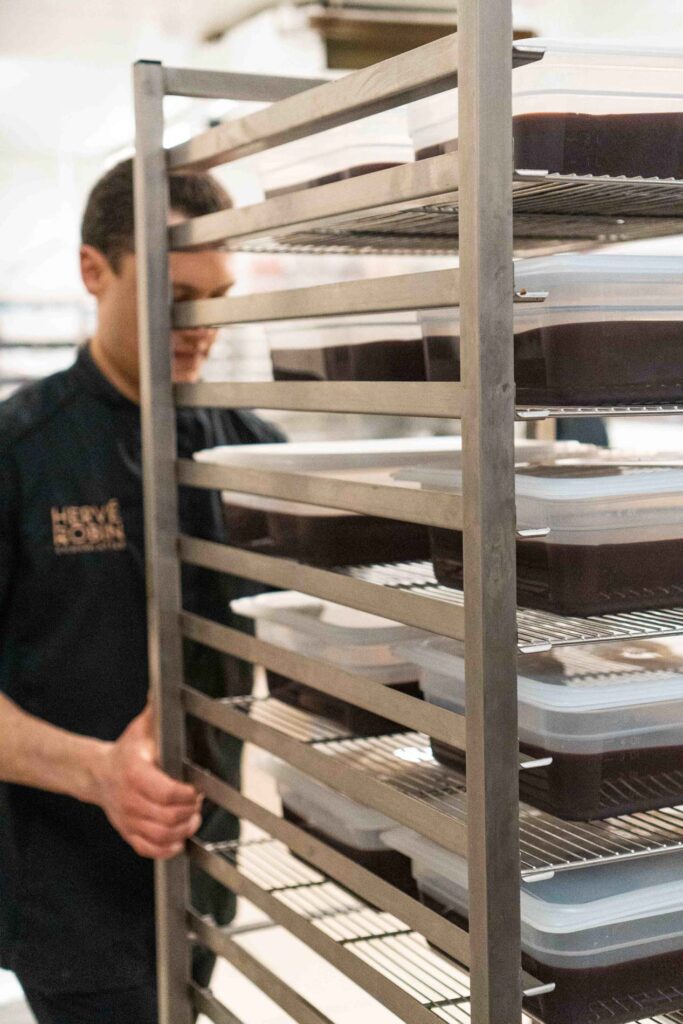
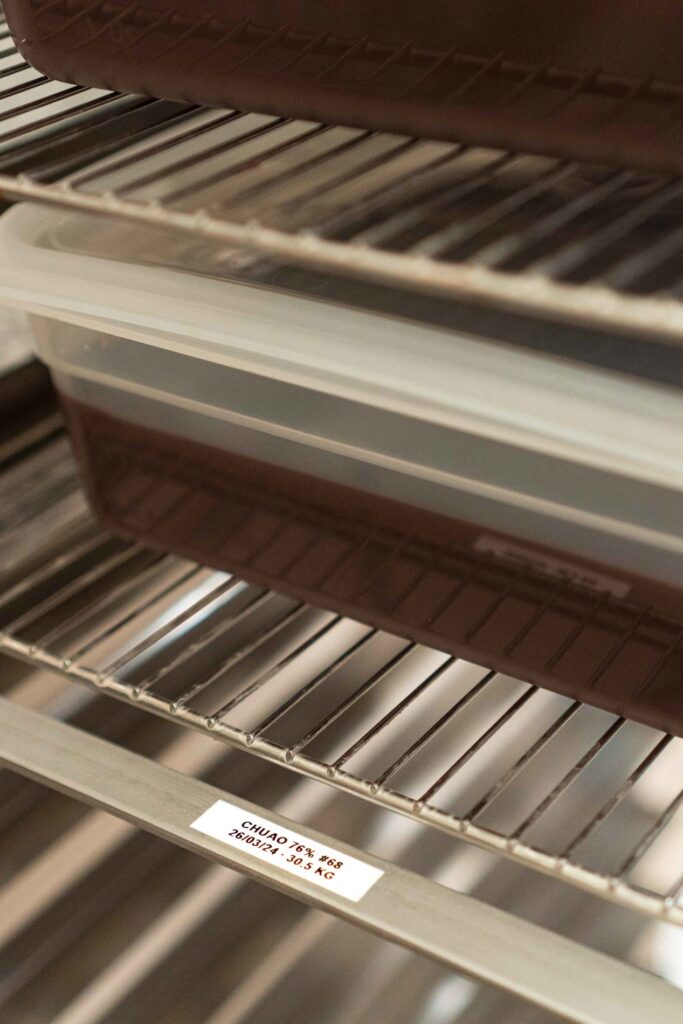

VIII. TEMPERING & MOLDING
Months after their creation, the time comes to take the plates out of storage to transform them into bars. A final step is required: tempering.
This involves melting the chocolate following a specific temperature curve, in order to obtain perfect crystallization of the cacao butter crystals.
This operation is carried out by a tempering machine and makes it possible to obtain the characteristic density of chocolate bars, providing perfect creaminess in mouthfeel, a smooth appearance, and the “snap” we hear when breaking the bar.

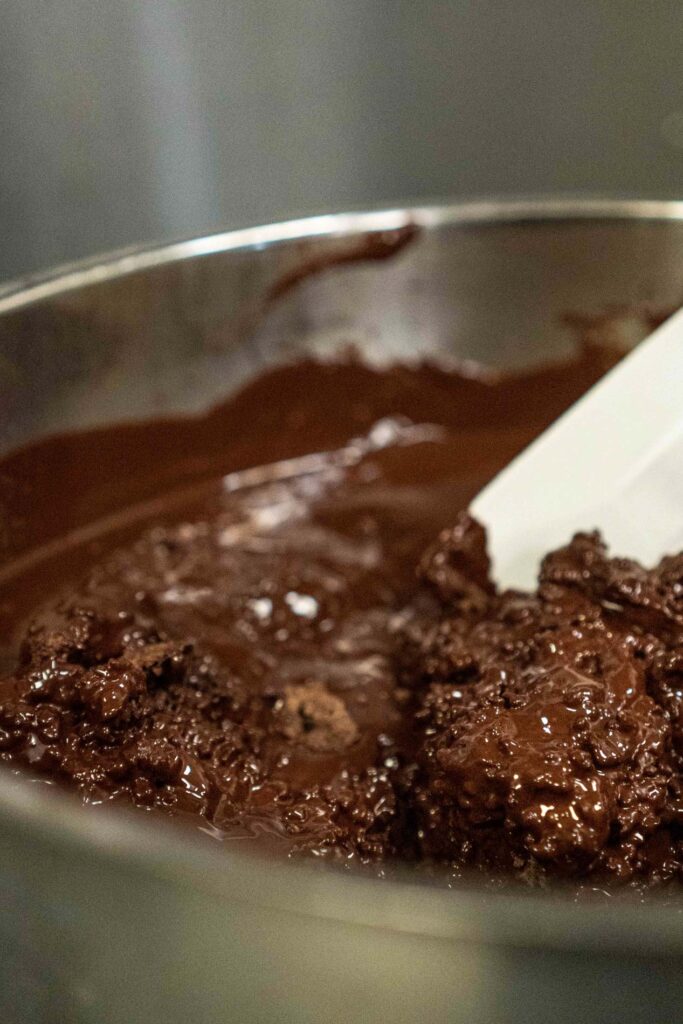
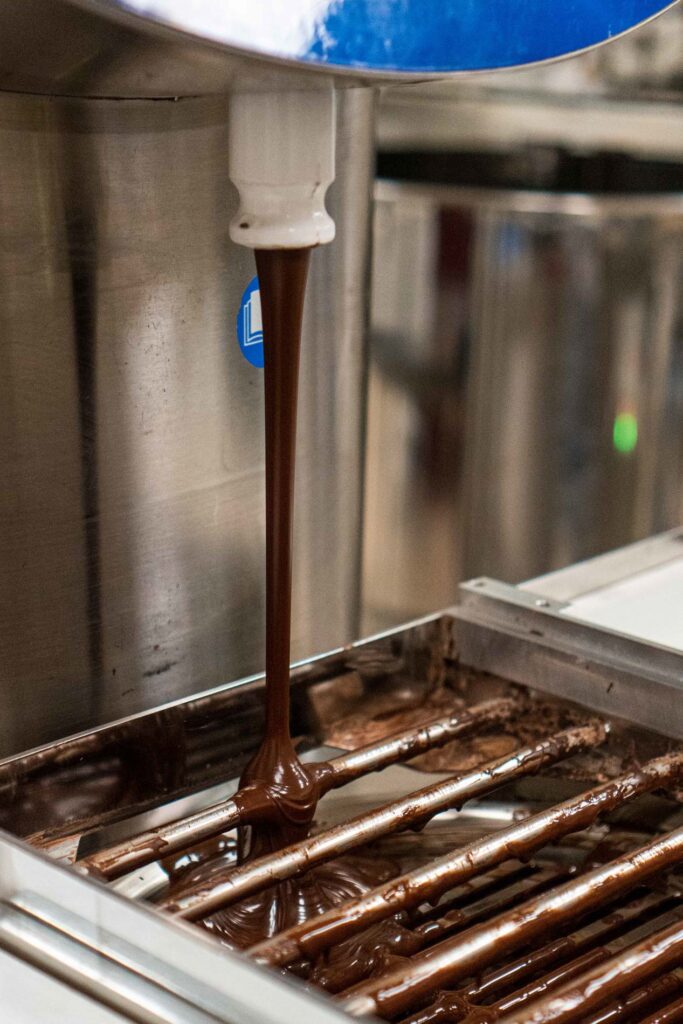
An accessory mounted on the machine allows to distribute the chocolate in streams and evenly fill the molds.
A gesture accomplished with dexterity, repeated as many times as necessary to make the 450 bars of the day.

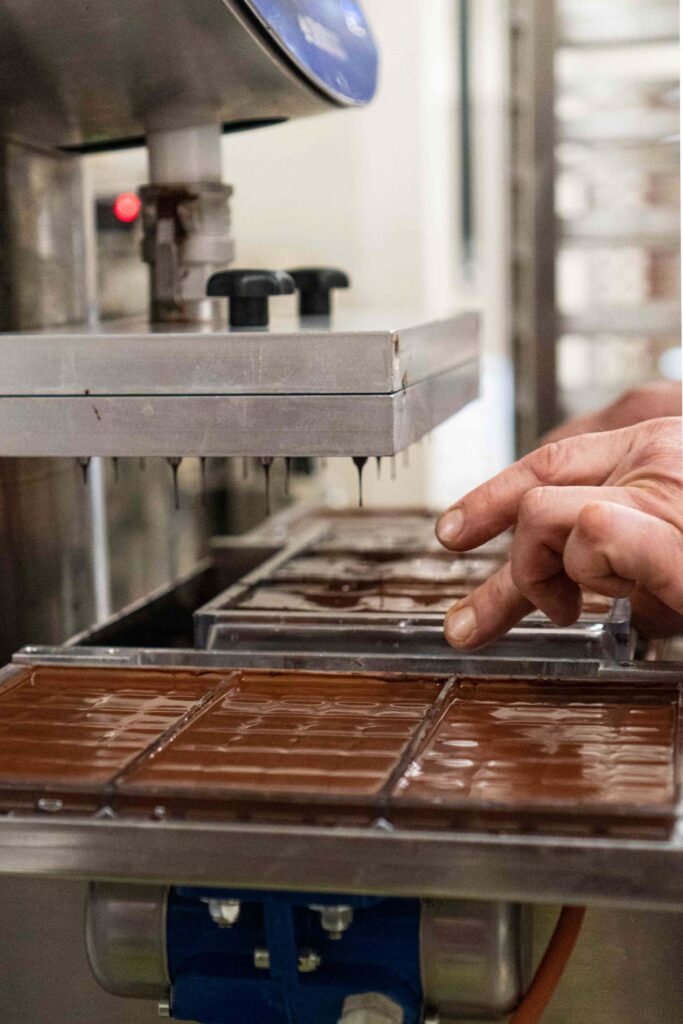
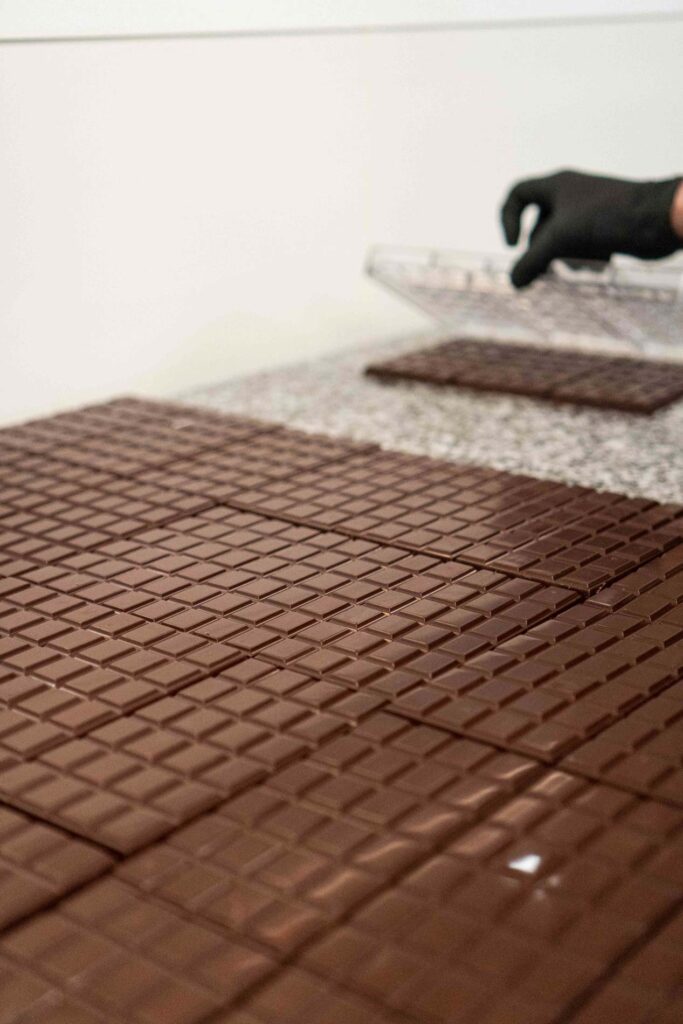


This step completes the transformation of cacao into chocolate. A long journey between Venezuelan soils and the Périgourdin workshop, between raw beans and grand cru chocolate.
A three-day cycle that Mathieu repeats throughout the seasons, in search of finesse, novelty, mastery, subtlety.
APPRECIATION
Much more than a treat or a guilty pleasure, Mathieu makes a chocolate that puts cacao in the spotlight again. Bars that encapsulate an intense synergy between the work of nature and that of a few human beings.
A tasting experience worthy of the time spent creating it, which I invite you to discover, and to rediscover, by taking the time to taste it.
These bars cannot be munched, they have to be appreciated. This chocolate cannot be chewed; it reveals its aromas as it melts. An invitation to slowness as a gateway to flavor.
SOURCES
Martin, Carla, “Sizing the craft chocolate market,” Fine Cacao and Chocolate Institute (blog), August 31, 2017, https://chocolateinstitute.org/blog/sizing-the-craft-chocolate-market/
Martin Christy et al, “IICCT – Level 1 certificate in chocolate tasting”
https://www.chocolatetastinginstitute.org/
INSIGHTS
RECIPES
PORTRAITS
©2024 Cacao Insights ☼ Made from the ♡


